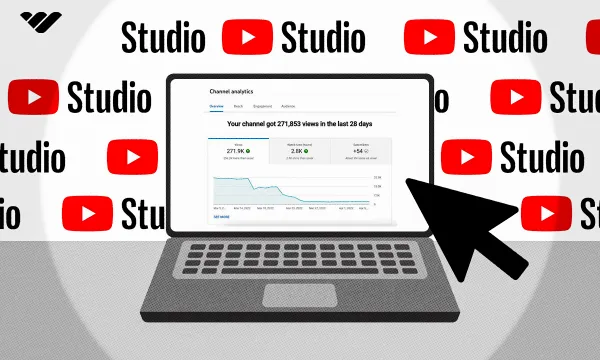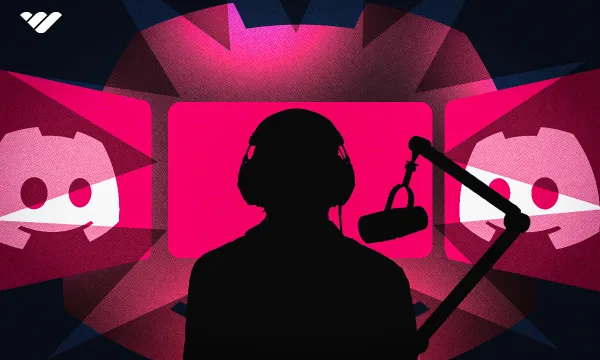YouTube is the kind of gig where you set your own goals. Some people want to do YouTube as a hobby or a way to get out some creative expression. But some people want to do YouTube to make money, and there's nothing wrong with that.
If you fall into that second group, then you might have a few questions about the process. We're here to help you figure out a timeline for YouTube earnings, what you need to do to start the process, and the best time investment for your bottom line.
We'll even tell you how to make more money with your YouTube channel by using Whop. Keep reading for our full guide to making money on YouTube.
When Do You Start Earning Money With Youtube?
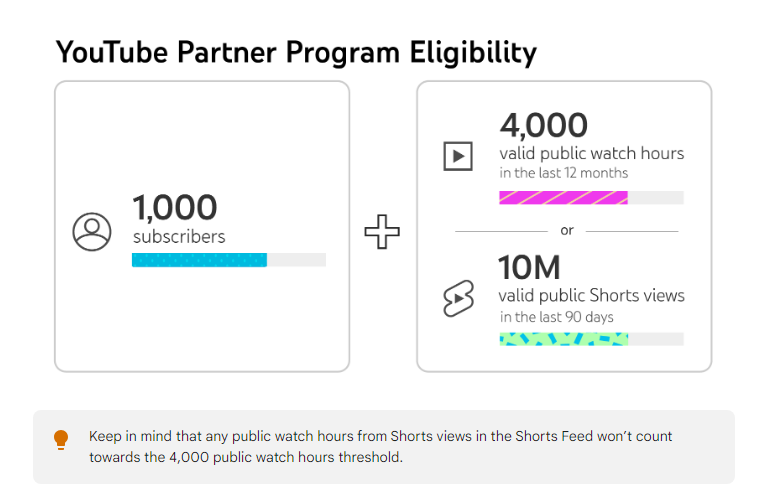
So, let's say that you start a YouTube channel today. When is it going to start bringing in some money?
In terms of YouTube paying you, this is a question with a straightforward answer right from the YouTube Partner Program terms of service: you'll get paid when you meet eligibility requirements and sign up with AdSense.
To even attempt eligibility, you have to meet the channel monetization policies, which include:
- You must live in a country or region where the YouTube Partner Program is available. Fortunately, the program is available in over 130 countries, including the United States.
- You cannot have any active Community Guidelines strikes present on your channel.
- You have to turn on 2-Factor Authentication for your Google account.
- You must be able to access the advanced features on YouTube.
- You need to have one active AdSense account linked to your channel or be willing to use the YouTube Studio to set one up.
If you meet all of these qualifications, then you're past the first hurdle. You can then move forward to meeting the eligibility for either Shorts or long-form YouTube videos. There are two ways to do this:
- Reach 1,000 subscribers and have 4,000 publicly viewable valid watch hours.
- Reach 1,000 subscribers and have 10 million public, valid views on Shorts videos in the last 90 days.
Once you've hit one of those benchmarks, you can apply for monetization through YouTube. But even if you aren't there yet, you may be able to start reaching out to brands as a nano-influencer.
How Much Money Can You Make With Youtube?
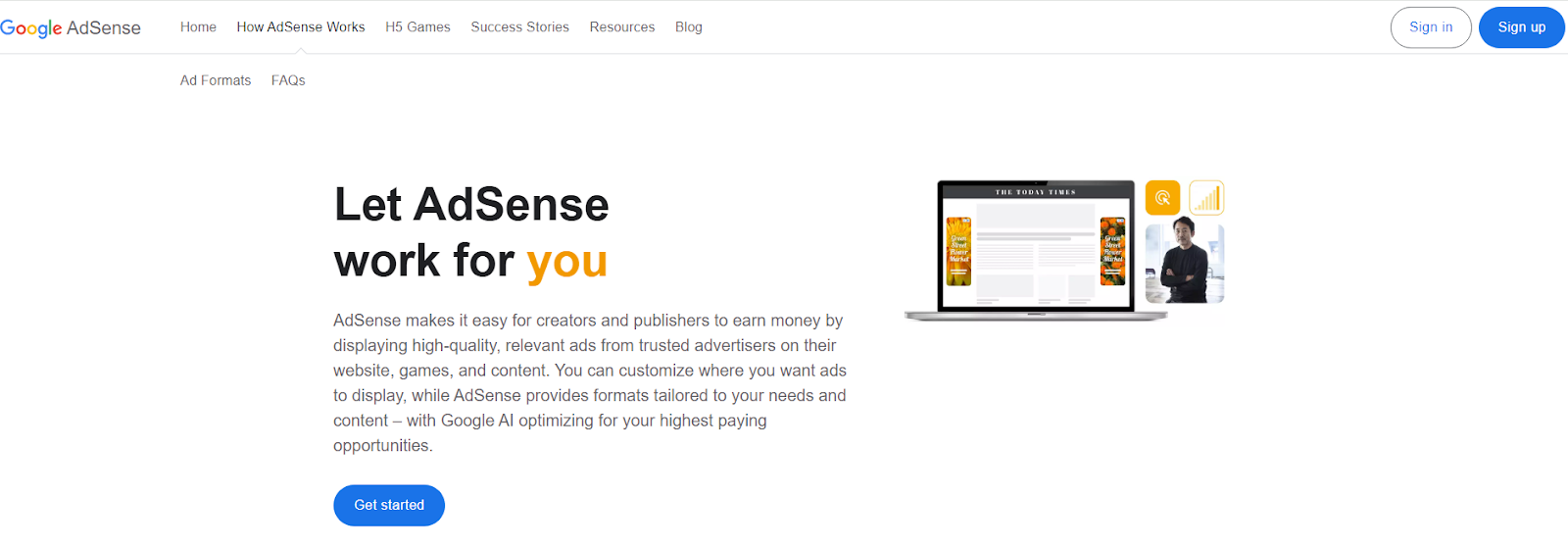
This is the million-dollar question—or maybe the thousand-dollar question, or even the hundred-dollar one. How much you make with YouTube depends on so many independent factors. A few of these are completely within your control and some aren't.
AdSense
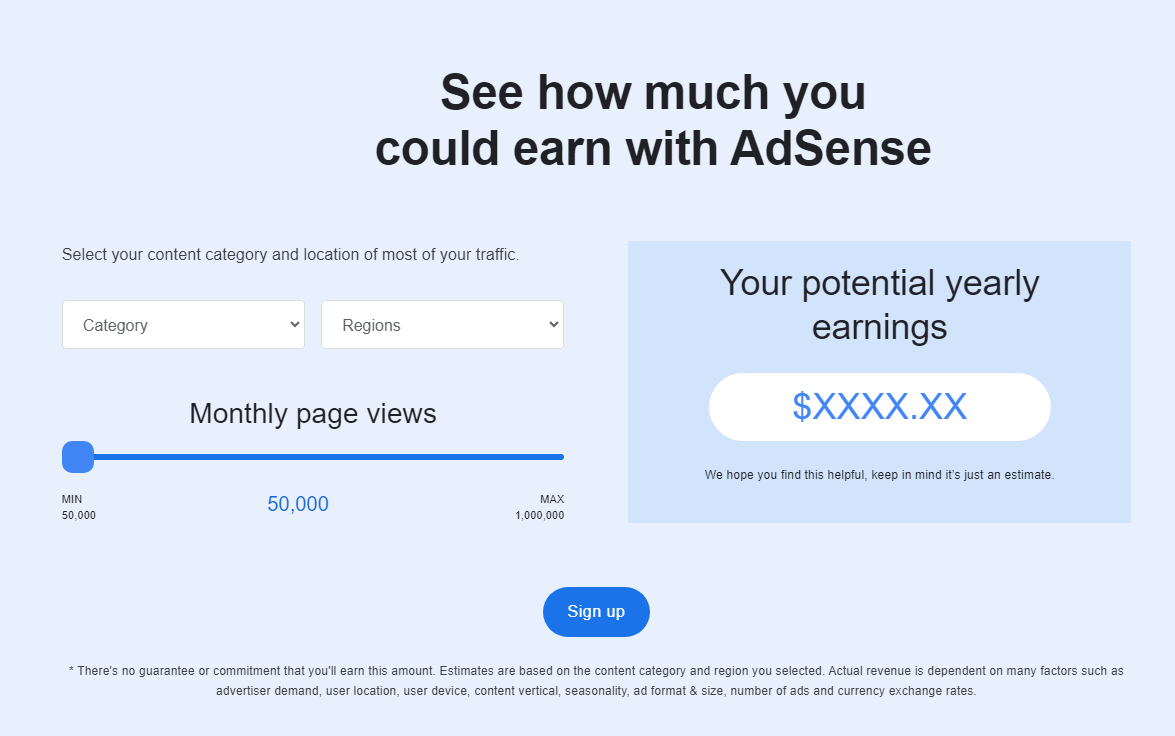
When it comes to AdSense, you can use the revenue calculator on the AdSense website to see the earnings that your region, category, and page views would make. For example, a beauty and fitness YouTuber from the Americas with 50,000 views per month will make an estimated $1,500 a year. Depending on your niche and location, your mileage may vary.
You can play around with the revenue calculator to see what area of YouTube content creation both interests you and would make the most appealing amount of money for you.
Sponsored videos
Even if your channel isn't quite ready for AdSense yet, you can still make money through sponsored content. This could be in the form of entire videos that the sponsor pays for and are centered on a topic, or as those quick 30-second ads that YouTubers stick into entirely unrelated content. (A certain VPN and a certain mobile game come to mind.)
When it comes to brand deals, how much you make depends on a few things. These include what kind of content you make, engagement metrics, and follower counts.
Here's a quick guide to each type of influencer and what they generally make through brand deals or sponsored videos. Remember that there's no hard and fast rule to how much money you can make, so these are just general guidelines.
| Influencer level | Follower count | $$$ per brand deal |
|---|---|---|
| Nano influencer | 1,000-10,000 | $20-$200 |
| Micro influencer | 10,000-100,000 | $200-$2,000 |
| Mid-tier influencer | 100,000-500,000 | $1,000-$7,000 |
| Macro influencer | 500,000-1,000,000 | $2,000-$10,000 |
| Mega influencer | 1 million+ | $10,000+ |
You may make more or less depending on how marketable your niche is and how much engagement your audience can bring to a brand.
If you're also established on other platforms, some brands will pay more for a combination of posts across YouTube and social media.
How Do You Get Paid on YouTube?
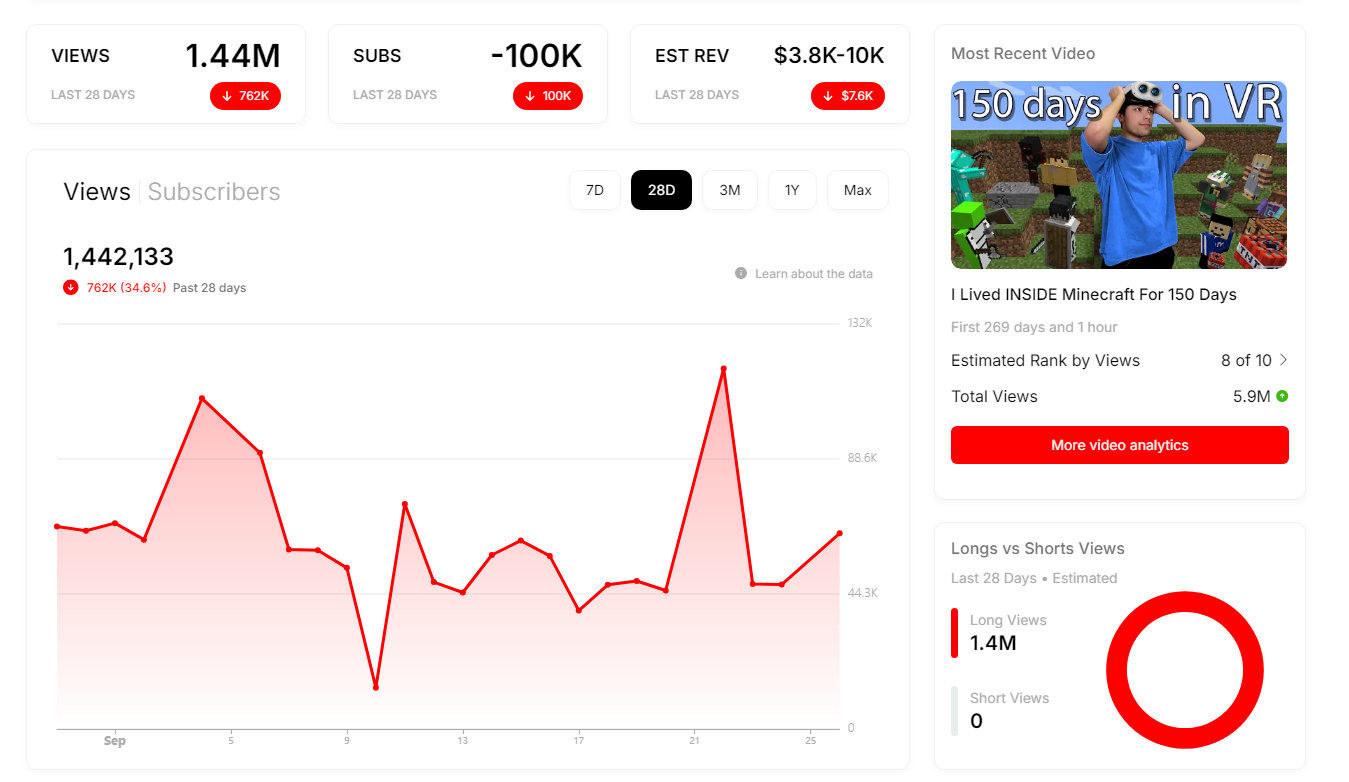
Since there are different ways to get paid as a YouTuber, the process varies by platform. To see how much money you'll make directly from your videos on YouTube, there are three main things you need to do.
1. Set up AdSense
First, you need to make sure your AdSense account is ready and working.
- Create your Google account. If you're making content on YouTube, you will likely already have one, which makes this step easier.
- Sign up with the AdSense website. You'll fill out the information on this form that includes things like your website URL, the account type you're trying to make, and what country or territory you'll be paid in.
- Submit your application. Make sure you review all of the details first. Not being accurate will slow the process down.
- Verify your address. Once you've been approved, you'll get a verification code that you enter into your AdSense account to prove you are who you say you are.
- Set up payment information. Without this, you won't get your money, so don't forget.
Now you're ready to move on to the next step.
2. Join the YouTube Partner Program
Next, you need to be a YouTube Partner. We've already covered the eligibility requirements, so once you've set up your YouTube account and met those requirements, here's what you do.
- Enable monetization. To do this, go to the YouTube Studio and choose Monetization. From there, click on Start. This will let you review the monetization requirements once again.
- Link your AdSense account. This one is exactly what it says, and you may have to wait a while for confirmation that the two accounts have now been linked.
- Review the policies. We all scroll past the T&Cs, but since this is about getting paid, I recommend reading them to know what you're signing up for.
- Submit your application. This is where YouTube reviews your channel and decides whether you're in or not. Most users report this can take 10 hours or more.
- Set up your preferences. Once you've been approved, you have a say in the ad formats and types of ads that play on your channel.
3. Track your metrics
By using YouTube Studio to view your analytics, you can look at some key metrics and use them to set goals.
Here are some of the things to look out for:
- Overview. This lets you see things like views, watch time, and how many subscribers you have.
- Reach. This will tell you what your click-through rate (CTR) is, and where the traffic to your videos is coming from.
- Engagement. These metrics will show you how long people watch your videos for, which can help you boost viewer retention times and minimize your churn rate.
- Audience. Not only is it important to know who is watching your videos, but you also need to pay attention to demographics. Creating a target persona can help here.
Monitoring your performance on a regular basis tells you what gets you the most views and what type of content pays the most.
How to Make the Most With YouTube Ads
There are a lot of things you can do to make more money with YouTube ads. The most financially successful YouTubers try to follow all of these, so check them out.
Create non-controversial content
Some niches on YouTube are more profitable than others, but one thing that definitely won't make you any money is controversial content. Companies don't want their advertisements running before or during a video that leaves viewers with a bad taste in their mouths.
Here are some tips to avoid the dreaded demonetization:
- Be content-conscious. If you want to keep your monetization, avoid heavier subjects like crime, war, mass tragedies, social justice, or politics.
- Watch your language. You are more likely to be demonetized for profanity in the opening moments of a video or the thumbnail and title. No matter, if you can avoid it entirely, it's usually best.
- Be careful with copyright strikes. There are plenty of options for royalty-free music; make sure you're using that to avoid your content being claimed or getting a copyright strike.
- You can clickbait a little, but don't mislead. A thumbnail, title, or description that is completely misleading can get you removed from the program.
- Follow Fair Use guidelines. If you want to use clips from another content creator, they need to adhere to the Fair Use guideline. This means that when using them, you are adding commentary, critique, or educational value.
Pay attention to ad types and placements
If you weren't aware, there are actually multiple types of ads that can play during your content on YouTube. Some of these ads pay differently, and some may be inherently more prone to drawing engagement from your viewers.
Here are the different types of ads:
- Skippable in-stream ads. Viewers can skip these after five seconds.
- Non-skippable in-stream ads. These cannot be skipped at all, and they can be up to 15 seconds.
- In-feed video ads. Users can't skip these at all.
- Bumper ads. These are quick ads with a six-second maximum that cannot be skipped.
- Masthead ads. These are special ads that are only available from a Google sales representative.
- YouTube Shorts ads. These are optimized for mobile viewers.
- Outstream ads and Accompany Content. These ads appear outside of Google.
Increase your viewer watch time
Watch time is one of the most important factors for determining how much AdSense money you'll get. The more viewers watch and engage with your content, the more value you hold for advertisers. If your video is longer than eight minutes, you may get a mid-roll video inserted in the content instead of just a pre-roll that plays before it. Mid-roll ads also increase your revenue.
To boost your watch time, make sure you're creating content that hooks viewers right off the bat. You want people to start watching and not even consider clicking off. Have an intro that's engaging, and then strive to keep them hooked until the very last second.
Longer videos also offer more watch time—but only if the viewer actually continues to watch. There are different pacing techniques that you can consider, like using cliffhangers or introducing a piece of information with a promise to return to it later in the video with a full explanation.
You can also keep viewer retention even after a video is over. End screens and playlists can encourage viewers to click on another piece of your own content, which reflects positively in your analytics.
Pay attention to audience demographics
You have to know who your audience is in order to make the content that they want to see. Even within a niche, you may find your viewers trending in a specific direction or responding best to certain kinds of content.
Using YouTube's analytics tool, you can monitor viewer audience information such as:
- Basic demographics like age, gender, and location
- Watch time from subscribers
- What else your audience watch/subscribe to
- What format your viewers watch videos in
This information can be leveraged to maximize your income. For example, older viewers with a higher retention rate may be more willing to sit through non-skippable ads, while you may realize you make more money focusing on sponsored content with a younger audience.
Grow your subscribers
This is the goal of every content creator on YouTube. The more people watch your stuff, the likelier you are to monetize your videos. Here are five tips to grow your subscriber counts.
- Be consistent. If you upload regularly, then your audience will stay engaged. Having a specific day and time that your videos go live every week will also help watching become a habit built into the lives of your viewers. You'll also have the additional benefit of a blessing from the algorithm, which always favors that level of consistency.
- Use calls to action. Calls to action, or CTAs, are the moments when you ask something specific from your viewers that beckons them to respond and engage with you. This can be asking a question that they answer in the comments, reminding them to like your video, or telling them to subscribe if they want to see more of your content.
- Engage with your audience. This one is an absolute must. Everyone likes to feel as though they're being heard and appreciated. Viewers who feel a personal connection to you are likelier to watch through your videos, not skip ads (to support you), and even partake in whatever off-platform revenue streams you pursue.
- Collaborate. Collaborating with other YouTubers allows their audiences to meet you, which opens you up to a new potential subscriber base. Because the situation is so mutually beneficial, other creators with similar views and subscriber counts are often willing to work together.
- Offer exclusive content. We'll cover this a little more in this article when we discuss YouTube memberships and the alternatives. Subscribers that enjoy you are often willing to pay a little more to gain access to exclusive content. This can include behind-the-scenes footage, bonus clips, early access, or even specific videos specially made just for paid subscribers.
Capitalize on market trends
Being yourself is important because you want your content to stand out and not feel exactly the same as other creators in your niche. But, at the same time, following trends is often where the money's at.
Here are some of the best ways to track trends on social media:
- Google Trends
- YouTube's trending section
- Trending hashtags on X (formerly Twitter)
- TikTok's Explore page
One of the best things you can do is be an early adopter of a trend. By getting your content out there before the market is saturated, you can make sure that you're the one at the top of those hashtags and trending pages. Being higher in the search results will boost your views, which in turn boosts AdSense. Of course, chasing trends can be hit and miss, so your main focus should still be staying true to yourself and your brand.
You can also make content that stays on top of what is generally popular, even if it isn't a viral trend. If you make discussion videos, cover topics of interest to the majority of your viewers in a timely way. Sponsors also enjoy when you can work trends into their content because they have a vested interest in being seen by as many people as possible—as do you.
The best money makers on YouTube have a style that is adaptable to whatever is popular at the moment, giving them an evergreen feeling. If you're reading this and you haven't started your YouTube channel yet, it might be some food for thought.
3 Tips for Maximizing YouTube Revenue
Would it come as a surprise if I told you that the best way to make money on YouTube is not actually through YouTube?
You may get money from views alone, but to get the big bucks, diversifying your income is super important. Below, I'll show you three of the best ways to improve your YouTube earning potential by a whole lot.
1. Create a private community
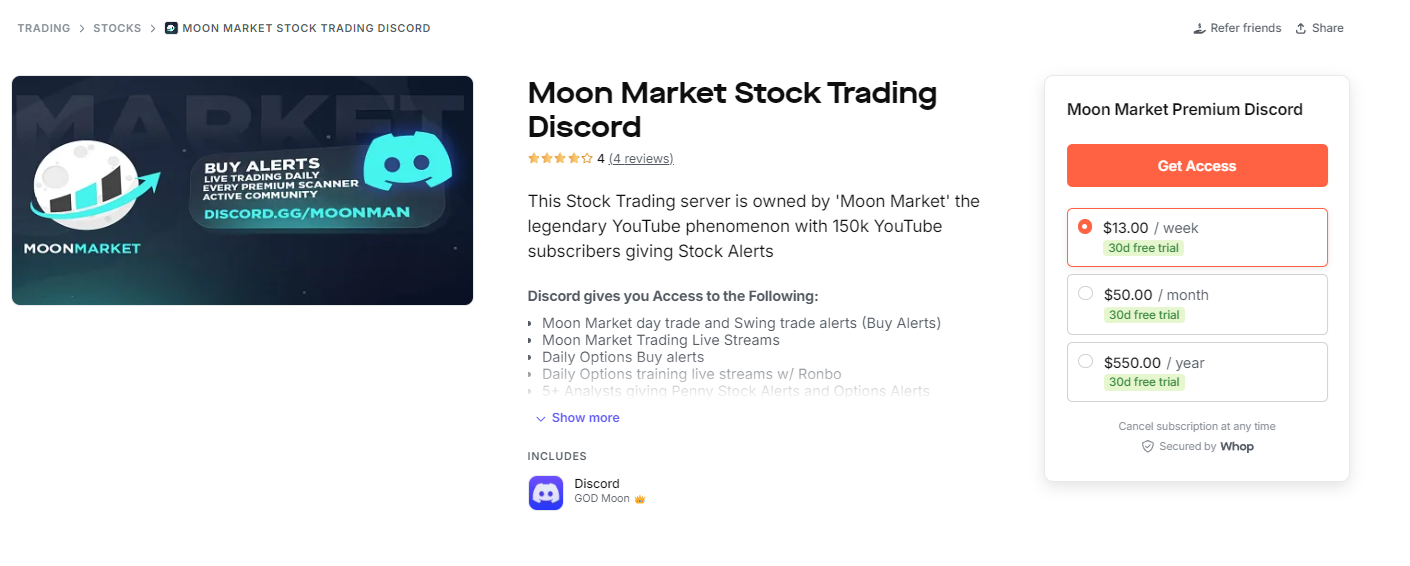
When you post videos on YouTube, your viewers only get to interact with you through the comment section. If you host live streams, they can type in the chat—but that's still very limiting. That's why many YouTubers and content creators set up private Discord or Telegram servers to interact with their followers in an exclusive (paid-for) circle.
Creating a private community comes with a lot of benefits, and very few—if any—drawbacks. Here are just a few of the pluses to think about:
- Recurring revenue. AdSense checks may vary from month to month depending on how well your videos have performed. With a regularly charged fee for a private community, you can be sure you have a more consistent income.
- Engagement with fans. A deeper level of engagement with fans can pay out in multiple different ways. Engaged fans have a higher level of loyalty and desire to support you, which means they have a higher conversion rate for product and service sales.
- Exclusive content and perks. You can offer extra goodies to your private community members that you can't give them through YouTube, such as behind-the-scenes content, podcast episodes, or one-on-one calls. Trust me—many fans would pay a hefty sum just to have a direct line to their favorite YouTuber.
- Upselling opportunities. YouTubers frequently upsell their audience on things like exclusive content, merchandise, webinars, ebooks, and other digital products. The best part? If you use Whop to set up your private community, you can sell all of those things in one place.
- Better monetization control. Circling back around to the first point, YouTube (or any social media platform) can be a tricky beast to deal with. Ad revenue can rise or fall in ways entirely outside of your control, and you are prone to demonetization often in ways you couldn't anticipate. Having income off the platform just ensures you'll never go entirely without income.
This kind of community can be ideal for encouraging engagement and getting a good look at your core demographic. Setting up your own community with Whop only takes a few minutes.
2. Sell online courses
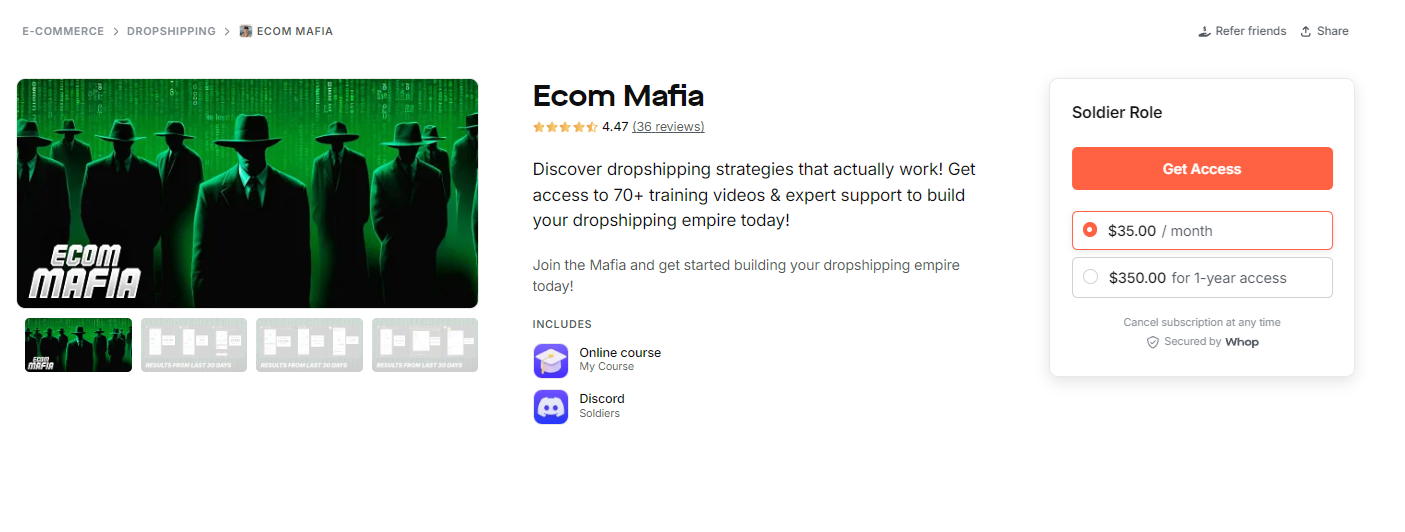
Knowledge is money, and if you're willing to turn your know-how into a cohesive course, you can make some serious cash. The top course creators on Whop charge up to $1,500 per week. Even if you're not aiming for the big leagues, selling online courses can be an excellent source of extra income, and it'll be fueled by your YouTube channel.
Admittedly, educational channels are the best option here. If you're sharing some useful info on your YouTube channel, people are bound to want to learn more. Let's say you're a programmer who talks about the state of the tech economy—well, that's just a hop and a skip away from your own comprehensive course that teaches others how to code.
Not sure what to talk about? Check out our list of course ideas that you could start making today.
If your channel is focused on entertainment, such as pranks or storytime videos, you may feel like you don't have much to talk about in the way of creating a course. Wrong—you can make a course on just about anything, and as a YouTuber, your content-creation knowledge will be sought after if you market it the right way.
Building a course on Whop is easier than if you were to use just about any other platform. You can upload course files in minutes, including PDFs, presentations, ebooks, and quizzes. You can also track course progression to motivate your students more effectively. With this, YouTube will become a funnel for your successful online business.
3. Set up an exclusive membership
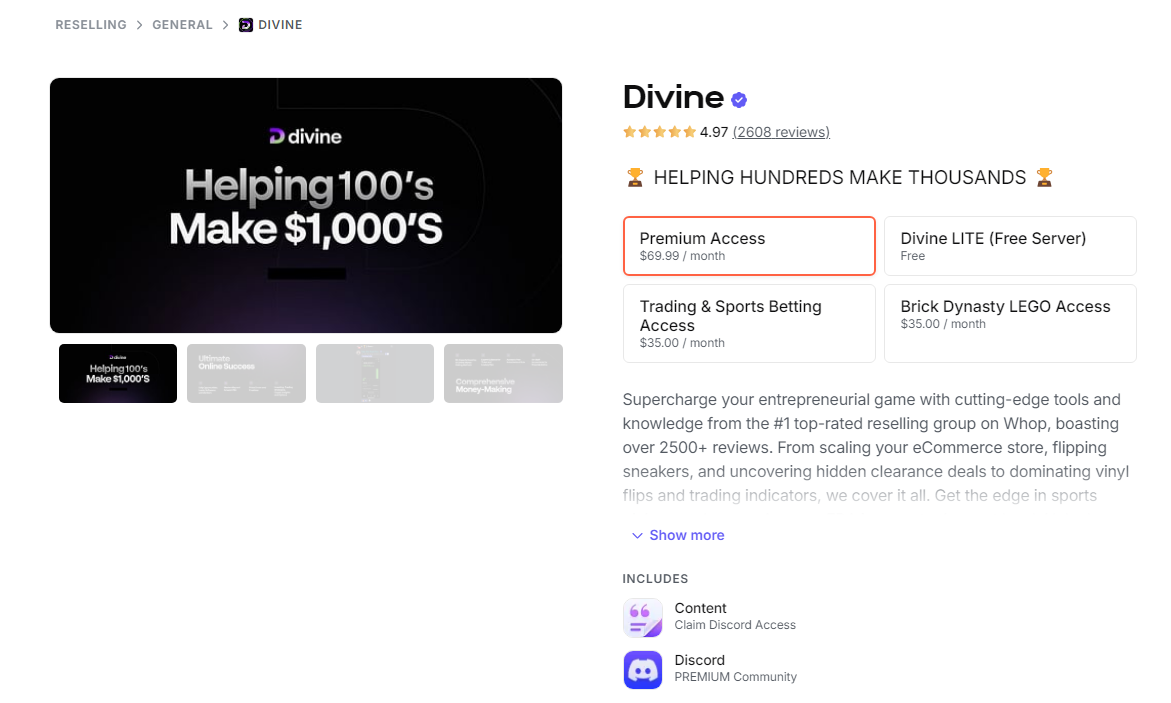
I know, I know—YouTube already lets you set up a paid membership, but that doesn't let you do much beyond sharing some extra posts and videos. If you want to go all the way toward making your followers happy, consider making your own whop instead.
Why should you go off-platform for this? For starters, for extra revenue. YouTube takes a 30% cut out of every membership, so every time someone shells out $4.99 or $14.99 to support you, 30% of that is never going to make it into your wallet. Whop only takes a 3% cut, saving you lots of money.
Moreover, Whop lets you truly build a platform for your followers. Think a one-stop shop for all things uniquely you. You can use Whop for any of the following:
- Selling ebooks
- Setting up one-on-one calls
- Sharing access to a private Discord server
- Creating and monetizing your own whop community
- Hosting a mastermind
- Scheduling games or live events for your followers
- Selling other downloadables, such as digital planners or bots
- Sharing fitness-related content like meal plans or workout plans
- Behind-the-scenes content
- Podcast episodes
- Consulting sessions
- And so much more.
Because there is no exclusivity requirement for either YouTube Memberships or Whop, you can also use both. You can choose to offer some exclusive content through the YouTube feature (like live streams on the platform), while others provide incentives for users to subscribe to you through Whop.
Join Whop and Monetize Your YouTube Channel
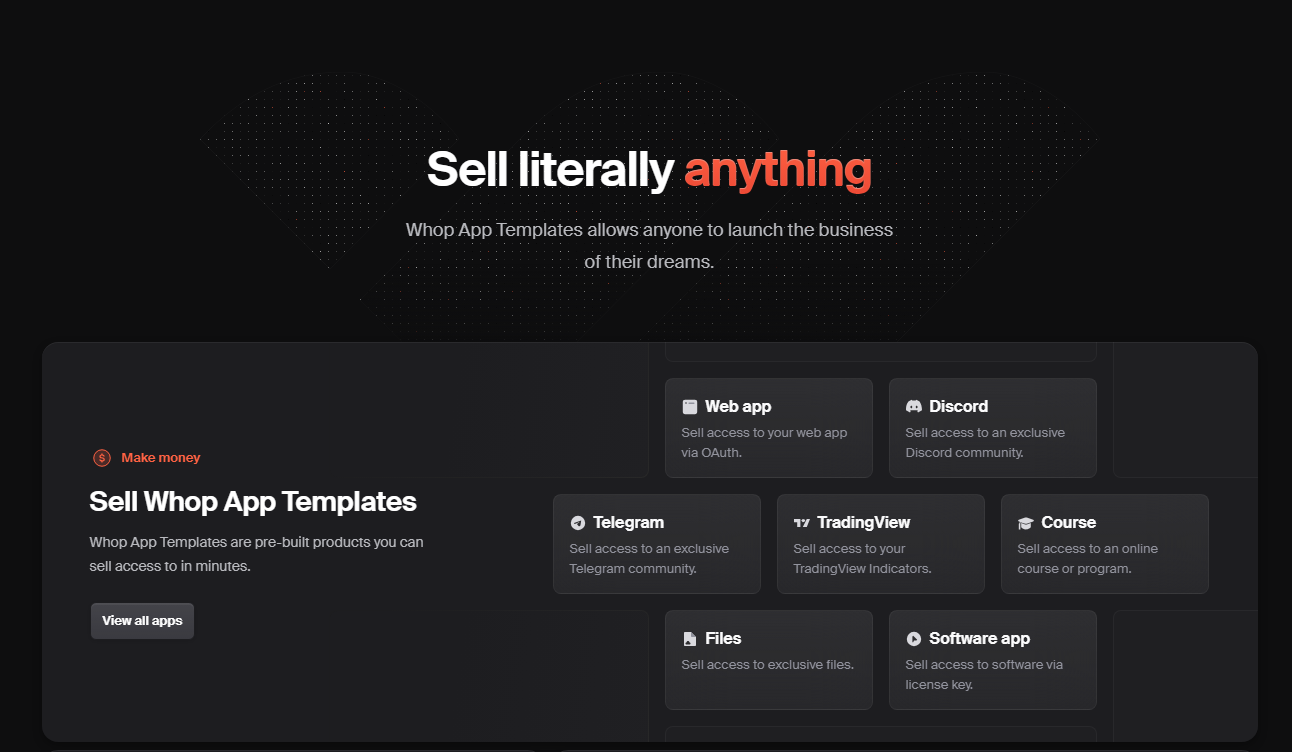
Ads are a core tenet of how people make money on YouTube, but they aren't the end-all and be-all. Diversifying your revenue stream is important, as banking on YouTube and nothing else can be a stressful way to live.
YouTube, and social media in general, is a fickle beast. Losing monetization or being suspended can happen even if you don't feel like you've done anything wrong. Moreover, with Google often changing up the rules for what pays well and what doesn't, it can be hard for creators to stay on top of things.
Don't put all of your eggs in one basket. Grow your YouTube channel and your earnings together with Whop.
Setting up your own whop only takes a few minutes, and once you're in, you get access to a platform that we've built for creators like you. Whop automates a lot of the aspects of being a content creator, from tracking customer analytics to sending out invitations and files as soon as they're bought.
It's just as important that Whop lets you do so much more with your entire platform. You're no longer just running a YouTube channel—you're a creator with a lot to offer, from ebooks to exclusive live streams that only paying members can access. It's the key to engagement, growth, and much higher earnings.
Whop can help you make the most out of your YouTube career. It'll make your followers happy with all the extra content, and it'll help you rest easy knowing that there's money coming from more than just one place.
Join Whop to level up your YouTube channel.
FAQs
How many subscribers do you need to make money on YouTube?
Technically, you can start making money as soon as you are eligible for and apply for monetization.
Just to give you a ballpark of how much someone with the bare minimum requirements makes, the lowest you'll see per view is about $0.002. You can get up to $0.012 per view, but it depends on the type of ad and your content.
So if you have a thousand subscribers and every single subscriber watches your video, you'll pull in a tidy two dollars. But remember: you do split this money with YouTube, so you'd actually be making between 45-70% of that.
How much do the most famous YouTubers make?
Most famous YouTubers and content creators have diversified their revenue streams. They do this through a combination of merchandising, creating companies and products, and doing brand deals or sponsorships. They also often establish themselves on other social media websites.
Here are some rough estimates of what these popular YouTubers make:
- Mr. Beast: $54 million annually
- Ryan Kaji of Ryan's World: $27 million annually
- Preston Arsement: $16 million annually
- Dream: $10 million annually
- Emma Chamberlain: $12 million annually
How frequently does YouTube pay creators?
YouTube pays monthly, usually between the 21st and 26th of the month. You will be paid on those dates for the previous month's earnings. The same figures will show up in your YouTube payment account balance between the 7th and 12th of the month.
Do keep in mind that to be paid, you must meet the Google AdSense payment threshold, which is $100 in the United States; this may be different in other parts of the globe.
What's the best way to make money on YouTube without ads?
The best way to make money on YouTube without ads or monetization is to expand your revenue earnings to another platform, such as Whop. For instance, you could set up a paid community or offer your followers one-on-one video calls to boost both engagement and earnings.
Is YouTube ad money taxable?
Yes, it is. As a creator, you're responsible for reporting your income from all sources of money you make through YouTube. To make sure you don't end up in a sticky spot, you should put aside some money from every check you get.
How much can I make on YouTube merch?
Viewers love to support their favorite YouTubers, so once you've established yourself as a creator with dedicated viewers you can launch a merch shop. You can even do this before you've joined the Partner Program if you think you have enough of an audience to make it worth it.
Income with merchandise is dependent on the profit split of the platform you choose to sell through, and how much you can actually sell.
What happens if you get rejected from the YouTube Partner Program?
If you don't get accepted into the Partner Program right away, don't worry. All is not lost. You still have options.
The first thing you should do is try to figure out why you were rejected. YouTube does provide you with a reason for rejection that you should be able to find in your email or on your AdSense account. It may be that you thought you met the criteria but didn't quite get there, or that they found some content on your page that didn't meet their guidelines.
YouTube will allow you to try and fix what's wrong. If it was a content issue, you can remove the content. You should also use this time to create more original content and work on improving your metrics. You can reapply once thirty days have passed.
